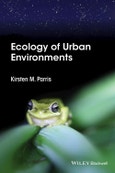- Examines the bio-physical processes of urbanization and how these influence the dynamics of urban populations, communities and ecosystems
- Explores the ecology of humans in cities
- Discusses practical strategies for conserving biodiversity and maintaining ecosystem services in urban environments
- Includes case studies with questions to improve retention and understanding
Table of Contents
Foreword xiPreface xiii
Acknowledgements xv
1 Introduction 1
1.1 Setting the scene 1
1.2 What is urban ecology? 1
1.3 Why is urban ecology interesting? 2
1.3.1 Urban environments are extensive and growing 3
1.3.2 Urban environments have inherent ecological interest 6
1.3.3 Urban environments are ideal for testing and developing ecological theory 6
1.3.4 The nature of urban environments affects human health and wellbeing 7
1.3.5 Urban environments are important for conserving biological diversity 8
1.4 The aims of this book 10
Study questions 10
References 10
2 Urban environments 15
2.1 Introduction 15
2.2 Primary biophysical processes associated with urbanization 19
2.2.1 Removal of existing vegetation 20
2.2.2 Construction of buildings, roads and other urban infrastructure 21
2.2.3 Replacement of permeable with impermeable surfaces 22
2.2.4 Reduction in the area of open space 22
2.2.5 Modification or destruction of aquatic habitats 24
2.2.6 Production of pollution and waste 25
2.3 Secondary biophysical processes associated with urbanization 28
2.3.1 Habitat loss, fragmentation and isolation 28
2.3.2 Climatic changes 28
2.3.3 Altered hydrological regimes 29
2.3.4 Pollution of air, water and soil 29
2.3.5 Altered noise and light regimes 30
2.4 Stochasticity in urban environments 31
2.5 Summary 32
Study questions 33
References 33
3 Population- and species-level responses to urbanization 41
3.1 Introduction 41
3.2 Responses to the secondary biophysical processes of urbanization 43
3.2.1 Habitat loss, fragmentation and isolation 43
3.2.2 Climatic changes 48
3.2.3 Altered hydrological regimes 49
3.2.4 Pollution of air, water and soil 50
3.2.5 Altered noise and light regimes 53
3.3 Biological introductions and invasions 57
3.3.1 Plants and fungi 57
3.3.2 Animals 59
3.4 Human disturbance 63
3.5 Stochastic effects on populations in urban environments 65
3.6 Summary 66
Study questions 66
References 67
4 Community-level responses to urbanization 81
4.1 Introduction 81
4.2 Selection: niche theories in urban ecology 84
4.2.1 The ecological niche and the environmental gradient 84
4.2.2 Habitat models 90
4.2.3 Ecological guilds and resource-competition models 94
4.3 Ecological drift: modelling stochasticity in urban communities 97
4.4 Dispersal: the movement of individuals through space 99
4.5 Diversification: the evolution of new lineages in urban environments 102
4.6 Summary 104
Study questions 105
References 105
5 Ecosystem-level responses to urbanization 114
5.1 Introduction 114
5.2 Carbon 116
5.2.1 Introduction to the carbon cycle 116
5.2.2 Effects of urbanization on the carbon cycle 119
5.2.3 Mitigation strategies 122
5.3 Water 127
5.3.1 Introduction to the water cycle 127
5.3.2 Effects of urbanization on the water cycle 127
5.3.3 Mitigation strategies 129
5.4 The nitrogen cycle 131
5.4.1 Effects of urbanization on the nitrogen cycle 132
5.4.2 Mitigation strategies 135
5.5 Summary 136
Study questions 136
References 137
6 The urban ecology of humans 146
6.1 Introduction 146
6.2 The urban form 150
6.2.1 Urban parks and open space 150
6.2.2 Urban sprawl and car dependence 156
6.2.3 Neighbourhood disadvantage and neighbourhood disorder 157
6.3 Pollution and waste 158
6.3.1 Outdoor air pollution 160
6.3.2 Indoor air pollution 161
6.4 Climatic changes in urban environments 162
6.5 Health inequities in the world’s cities 163
6.6 Summary 164
Study questions 165
References 165
7 Conserving biodiversity and maintaining ecosystem services in cities 175
7.1 Introduction 175
7.2 Strategies for conserving biodiversity and maintaining ecosystem services in cities 177
7.2.1 Integrate urban ecology with urban planning and design 177
7.2.2 Protect biodiverse landscape features and important biophysical assets 180
7.2.3 Grow the green city 182
7.2.4 Maintain or re-establish landscape connectivity 185
7.2.5 Use small spaces 187
7.3 Novel habitats, novel ecosystems 190
7.4 Summary 192
Study questions 192
References 193
8 Summary and future directions 204
8.1 Introduction 204
8.2 Do we need a new theory of urban ecology? 204
8.2.1 The complexity of urban ecosystems 205
8.2.2 The human domination of urban ecosystems 206
8.2.3 The uniqueness of urban ecosystems 206
8.3 The definition and scope of urban ecology 207
8.4 Do we need a new theory of urban science? 208
8.5 Future directions 209
Study questions 210
References 211
Index 214








